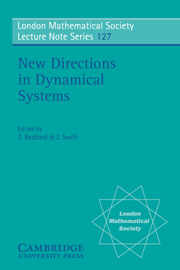Book contents
- Frontmatter
- Contents
- Preface
- Introduction
- Universality and Renormalisation in Dynamical Systems
- Smooth Dynamics on the Interval (with an emphasis on quadratic-like maps)
- Global Bifurcations in Flows
- Knots and Orbit Genealogies in Nonlinear Oscillators
- Limit Cycles of Polynomial Systems – Some Recent Developments
- Bifurcations with Symmetry
Global Bifurcations in Flows
Published online by Cambridge University Press: 23 December 2009
- Frontmatter
- Contents
- Preface
- Introduction
- Universality and Renormalisation in Dynamical Systems
- Smooth Dynamics on the Interval (with an emphasis on quadratic-like maps)
- Global Bifurcations in Flows
- Knots and Orbit Genealogies in Nonlinear Oscillators
- Limit Cycles of Polynomial Systems – Some Recent Developments
- Bifurcations with Symmetry
Summary
INTRODUCTION
Bifurcation theory is frequently used to understand the appearance of complicated motion in dynamical systems. As a parameter of the problem is varied, a family of differential equations may pass through a structurally unstable system at which the qualitative behaviour of the system changes: a bifurcation occurs. Usually, the effect of a bifurcation is to create or remove one or more periodic orbits from the system as, for example, in saddle-node or period-doubling bifurcations. These familiar bifurcations are examples of local bifurcations; the structurally unstable object is a non-hyperbolic stationary point (of the flow or an associated return map) and they can be investigated by a local analysis of the map near the non-hyperbolic stationary point. In this review we study some global bifurcations. Here, the structurally unstable object depends on global properties of the flow. In particular, we shall concentrate on bifurcations associated with homoclinic orbits (trajectories bi-asymptotic to the same stationary point of the flow in both forwards and backwards time, see Fig. I). The goal of the work presented here is similar to the goal in local bifurcation theory: a description of systems near structurally unstable systems of low codimension. However, the approach below is geometric and depends on global properties of the flow, whilst the approach to local bifurcations (normal forms) is algebraic.
Consider autonomous ordinary differential equations in ℝn,
where x ∈ ℝn and f: ℝn → ℝn is a smooth (continuous with first derivatives Lipschitz continuous) vector field. We shall assume that f(0) = 0 so that the origin, 0, is a stationary point of the flow.
- Type
- Chapter
- Information
- New Directions in Dynamical Systems , pp. 120 - 149Publisher: Cambridge University PressPrint publication year: 1988
- 7
- Cited by



